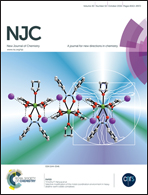Cyclodextrin assisted enantiomeric recognition of emtricitabine by 19F NMR spectroscopy
Abstract
A simple, rapid, precise and selective 19F NMR spectroscopic method was developed and validated for the quantitative determination of (R,S)-(−)- and (S,R)-(+)-enantiomers of emtricitabine using cyclodextrins as chiral recognition agents. Different parameters including the type, temperature and concentration of the chiral selector affecting the enantioresolution of emtricitabine were optimized. Among the different chiral selectors studied, α-cyclodextrin displayed the highest resolution of 19F NMR signals of (R,S)-(−)- and (S,R)-(+)-emtricitabine enantiomers. The binding constants (K) of the complexes determined from 19F NMR titration curves indicated that the α-CD forms a stronger complex with (R,S)-(−)-EMT (6.09 M−1) than with (S,R)-(+)-EMT (3.88 M−1). The enantioselectivity (α = 1.57) also indicated that α-CD was more suitable for recognition of the enantiomers of (R,S)-(−)- and (S,R)-(+)-emtricitabine by 19F NMR spectroscopy. The complexation process of emtricitabine with α-CD in D2O was also investigated by 2D 1H ROESY NMR experiments. The method was validated in terms of accuracy, precision, linearity, LOD and LOQ. The linear ranges of the calibration curves were 0.0007 to 0.0135 mmol mL−1 in D2O for both the enantiomers. The limit of detection (LOD; S/N = 3) and the limit of quantification (LOQ; S/N = 10) were 0.099, 0.096 and 0.33, 0.32 μmol mL−1 for (R,S)-(−)- and (S,R)-(+)-emtricitabine enantiomers respectively. The accuracy of the method was established by spiking with known amounts of enantiomers and the found values ranged between 95 and 103% with a relative standard deviation of <7%.


 Please wait while we load your content...
Please wait while we load your content...